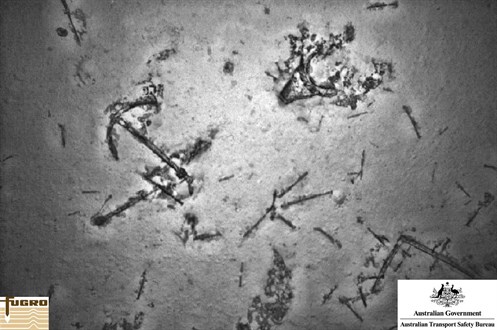Port of Antwerp Plans Namibia Hydrogen Harbor
(Bloomberg) — Port of Antwerp Bruges plans to develop a €250 million ($267 million) hydrogen and ammonia storage and export facility at the Namibian Port of Walvis Bay, together with...
The Fugro Equator, fitted with state-of-the art multibeam echosounder equipment, has been conducting a bathymetric survey of the seafloor in the search area for missing flight MH370 in the Indian Ocean. Photo courtesy Fugro
A previously uncharted shipwreck discovered on the seabed of the Indian Ocean within search area for Malaysia Airlines flight MH370 has the Australian-led search team optimistic that if the missing aircraft is nearby, it will be found.
According to the Australian Transportation Safety Bureau (ATSB), the MV Fugro Equator’s deep tow system recently detected a cluster of small sonar contacts in the southern part of the search area, 12 nautical miles to the east of the “7th arc” search area.
“We were cautious about this,” said the ATSB’s Peter Foley, Director of the Operational Search for MH370. “There were characteristics of the contact that made it unlikely to be MH370, but there were also aspects that generated interest, multiple small bright reflections in a relatively small area of otherwise featureless seabed.”
Although a careful analysis of the sonar data revealed that debris was “of potential interest but unlikely to be related to MH370,” officials decided that a more thorough investigation was in order.
MV Fugro Supporter, a multi-purpose offshore survey vessel also involved in the search, was tasked to divert on its passage between two search areas and further investigate the contact, performing a high-resolution sonar scan using the AUV.


The ATSB said the high-resolution data revealed a large number of sonar contacts lying very close to the seafloor at a depth of around 3,900 meters. The majority of the contacts were comparatively small – around the size of a cricket ball – interspersed with a few larger items, the biggest being box shaped and approximately 6 meters in its longest dimension, according to the ATSB. An additional AUV low-altitude mission was later undertaken using the underwater camera to gather images of the field.
The ATSB said that an analysis of the images this week revealed that the debris was indeed man-made, but that it was actually the previously uncharted wreck of a ship.
“It’s a fascinating find,” said Foley, “but it’s not what we’re looking for. We’re not pausing in the search for MH370, in fact the vessels have already moved on to continue the mission. Obviously, we’re disappointed that it wasn’t the aircraft, but we were always realistic about the likelihood. And this event has really demonstrated that the systems, people and the equipment involved in the search are working well. It’s shown that if there’s a debris field in the search area, we’ll find it.”
The Boeing 777-200ER aircraft has been missing since disappearing from air traffic control radar on March 8, 2014 after taking off from Kuala Lumpur, Malaysia to Beijing, China with 227 passengers and 12 crew. The underwater search zone for the aircraft comprises about 60,000 square kilometers along the so-called “7th arc” in the southern Indian Ocean, where MH370 had the last communication with a satellite.
Join the gCaptain Club for curated content, insider opinions, and vibrant community discussions.


Join the 105,870 members that receive our newsletter.
Have a news tip? Let us know.
Access exclusive insights, engage in vibrant discussions, and gain perspectives from our CEO.
Sign Up




Maritime and offshore news trusted by our 105,870 members delivered daily straight to your inbox.



Essential news coupled with the finest maritime content sourced from across the globe.
Sign Up